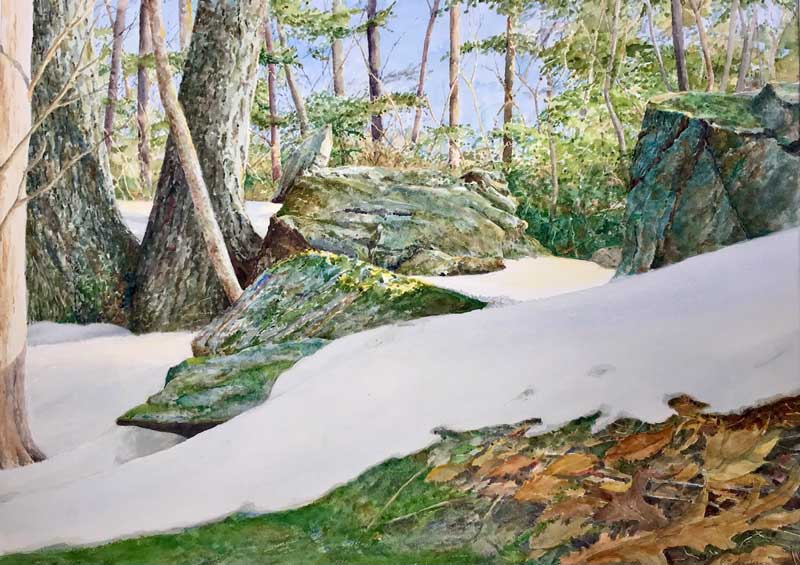by Carlene Phillips ·
Friday, November 10, 2023
I was privileged to meet with Pete Jackson in his studio on Jacob Gates Road and talk to him about his journey as an artist and his entry in this year’s juried art show, “Destination: Nature 2023,” a partnership between Fivesparks and the Harvard Conservation Trust, of which Jackson has been a member since 1981. His watercolor “Eye-level Scape” hung on the wall beside where we stood, and I never tired of looking at its clean lines, beautiful green-blue hues, and most of all its luminosity. “Painting’s not about what you see but what you feel, what you experience,” said Jackson. “If you’re inspired, you’ll dig deep.”
Even if I hadn’t known, I would have recognized this painting as “a Jackson” based on his prize-winning entry in last year’s show. Both are scenes of elemental nature and have the same fine lines that give such clarity of detail, whether to a stretch of barbed wire or, here, to the layers of lichen on a large, jagged rock. In both, expanses of snow create a cold light in contrast to the warmer light from the subtle color elsewhere in the painting. Jackson said in this painting he “has pushed color more than usual.” The simplicity of the content—rocks, trees, slopes—belies what Jackson said was “complicated compositionally,” especially with the angles of the rocks.

“Eye-level Scape” by Pete Jackson. �(Courtesy photo)
“Eye-level Scape” captures a part of the Eastern Green-way near the southern end of this north-south corridor linking Conservation Trust lands near his home, and Jackson’s perspective is looking eye-level across a steep area with plateaus on the ledge. This brings the viewer close into the land rather than looking at it from above or afar. But Jackson has also taken artistic license to create a scene that could not naturally occur. The fallen oak leaves and wash of snow in the foreground suggest a November day, but the blue-greens of the lichen on the rocks, which is what most attracted Jackson, are seen in July. The angle of a tree and sizes of the rocks have been altered to bring better balance to the composition and to tie things together. The frame, which perfectly complements the natural elements in the painting, is made from a piece of ash that Jackson salvaged from shelving under the staircase during the renovation of Old Bromfield.
Jackson has never taken a lesson in watercolor. His introduction to painting was as a kid growing up in Philadelphia, watching his grandfather at his easel. Although he liked to draw in pen and ink, and he and his cousin loved Mad magazine and were fascinated with surrealism and Dali’s melting clocks, Jackson wouldn’t take up painting until many years later.
After graduate school and while living in California, Jackson bought a sketch pad and a kid’s set of watercolors at a toy store. He would take these materials and do quick pictures while he was backpacking. One weekend he sat down with some slides of country scenes in an area of Pennsylvania near where he grew up, and he painted three different watercolors. These works established the approach he still uses in his work. The irony of painting Pennsylvania scenes in California was not lost on him, but for him there was nothing inspiring in the landscape there. He would return to Pennsylvania off and on, and he entered juried shows in California with Pennsylvania subjects. After 10 years he and his wife Kathy moved east.
Jackson did no painting in the 1990s, but when he retired in 2000, he told himself, “I’ll have a show in one year.” He entered work at the regional juried show at Fitchburg Art Museum, where he won the top painting prize.
Jackson purchases the best watercolor materials, but he buys less expensive, 140-pound paper rather than the 300-pound paper preferred by many watercolorists. He likes the surface of the thinner paper, which he soaks and stretches so it is taut when it dries. He lays the paper on a large flat surface and stands to paint, constantly stepping back or moving closer to look at his work, turning it in different ways to see its balance. “I’m using engineering when I’m painting,” he said.
Watercolor takes a lot of planning, because once paint is applied, it’s not easy to change it. “Oil can be scraped off,” Jackson said, “but there’s no do-over with watercolors.” He uses limited colors in his work, and he joked that his mom was always telling him his paintings were too monochromatic. He starts with any places that are going to be white and works around the blank paper itself; there is no paint that is truly white. For “Eye-level Scape,” he used veridian, a green-blue color, as a base for the lichen on the rocks—the brightest color in the painting. He mixed a whole range of other colors with the veridian to get the multiple shades for layers of the lichen. He learned what worked by experimenting with mixing colors on a separate paper.
One of the best things about watercolors is their capacity for translucence, for holding light. What’s most challenging is the rapidity with which you need to paint—before the paint dries or before it runs. Jackson quoted from an article written by Boston Globe art critic Murray Whyte about the collection of watercolors at Harvard University. “Unlike any other media, the end result is a negotiation between what you have in mind and a material with a mind of its own.” Looking at Jackson’s entry for “Destination: Nature 2023,” I would say Jackson won the negotiation here.